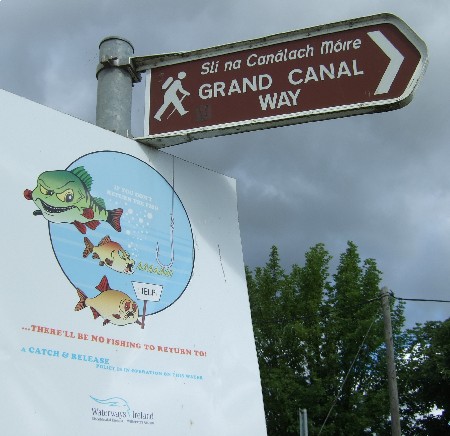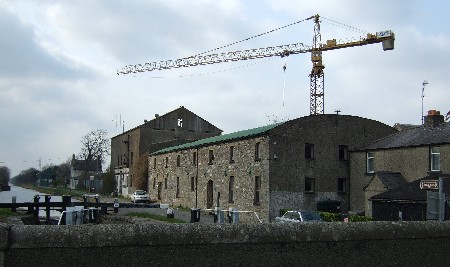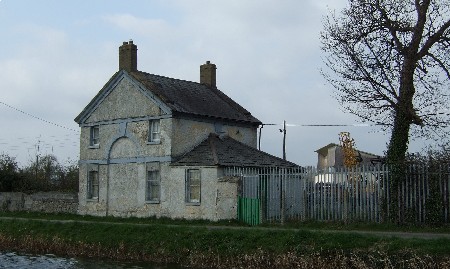|
Green Route – 12th Lock Lucan to 3rd Lock in Inchicore

This route was officially opened last month, and opens up a distance of 8.5km of quality pedestrian and cycling paths monitored by CCTV and public lighting.
There is a 'slight' drawback for cyclists though, in that the 'rothars' do not fit through the 'kissing gates' unless they are lifted through!!! There are 12 such gates on the stretch. You'll have muscles where you never had them before!!!
Extensive tree and shrub planting has taken place with as many as 1,000 extra native Irish trees and 44,000 shrubs along the way.
Provision has been made for enhanced habitats for flora and fauna, and we're told that 16 bat boxes and 12 otter holts, are also in place. Other species listed as found along the Grand Canal are Moorhens, Pike,
Crayfish, Perch, and numerous wild flowers.
There are also several fishing points and boating areas along the route. Fishermen are reminded to throw the fish back in once caught.

Indeed a sign of the times – among the 200 signs along the route – is the fishing notice in no less than 11 different languages.

Some dates……
Construction began on The Grand Canal in 1756, when Thomas Omer was appointed Engineer. Work commenced at Clondalkin and went west. By 1763, 12 miles of the canal had been completed with three locks, six bridges, seven aqueducts and four lock-houses – all at a cost of £57,000. The Rt. Hon. Agmondisham Vesey of Lucan House was a director of the Grand Canal Company at this time.
In 1803, the Grand Canal was connected to the Shannon.
By 1852, the last passenger boat was withdrawn, due to the coming of the railway.
For the next hundred years or so, there were mostly only trade boats on the canal carrying the likes of turf from the bogs of the midlands to Dublin City. The last of these boats belonged to CIE and was withdrawn in 1960.
In 1986 the Office of Public Works took over the system. Ten years later it was transferred to the Dept. of Arts, Culture and Gaeltacht, and in 1999 it was transferred to Waterways Ireland, a North/South Body established after the Good Friday agreement.
Old Buildings
On the opposite side of the 12th Lock Bridge, the walker can take off along the northern bank of the waterway, though it is not as yet a developed walk, and can be quite muddy in places.
However, it is worth taking a look at the buildings along here.

Nearest the bridge is the Lockkeeper's House. Generations of the Condron family have been Lockkeepers here.
The next building was at one time a mill, purchased by Shackletons back around 1848, some years before they acquired Anna Liffey Mill at Lucan.
Layers Mash and Pig Meal were produced here, and also Grass Meal from grass cut at Baldonnel Aerodrome between May and October, which was dried and ground to a bright green power for winter feeding. This mill closed down in 1978.
Omer's Cottage
A little further along is an early Lockkeeper’s House, designed by Thomas Omer in the 1750s. Omer was an engineer in the early days of the canal's construction.

Rumour has it that this house is to be restored – we'll wait and see.
In behind it are the Clubhouse and grounds of Lucan Sarsfields GAA Club.
There are lots and lots of interesting areas along this section of the Grand Canal, whether you just like the leisurely stroll, or power walk, or cycle, if you're interested in the flora and fauna, or even if you just want to explore this very old area.
Mary Mulhall
(Ref: Treasures of Lucan; Waterways Ireland)
|